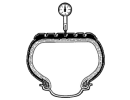
The tyres of a car are in plain view and therefore easy to check. In order to find out if the tyres are still in good shape, you need to check each tyre individually. Start by measuring the depth of the tread, this will give you good idea of the lifespan. Because a tyre needs a minimum of 1/16th of an inch (or 1.6 mm) tread depth for MOT approval.
If you want to be sure that you will not lose control of the car during heavy showers, you will need at least an extra 1/16th of an inch. These numbers are interesting when you want to save some money on maintenance. If you are buying a used car, you will be aiming for a year of cost free motoring. It is recommended that you get at least 3 or 4 /16th of an inch (5 to 6 mm). It depends of course on your driving style and mileage how you actually get through the first year.
Tread depth
For a quick impression of the tread depth, check the rubber lumps within the tread. These lumps are indicators that show the last 1/16th inch of the thread. You can find these indicators using your fingers or a pen. If the indicators are laying seamless to the tread (like in the picture below), you need to change the tyres as soon as possible. If these indicators are still well within the profile, the tyre is probably in a good condition. The exact condition can only be seen with experience or with a tread depth measuring instrument.

Note! When the wheels are not properly aligned, the tread wears uneven. This means that the tread can be in good condition on the outside, while it is completely worn on the inside. That is why you have to check the width over the full width of the tyre.
Damage
Because tyres are usually changed in pairs, there will be little difference in wear between the left and right tyres. However, you do have to check the tyres separately, because sharp objects may have damaged each one individually. It is possible that one of the tyres has little rips in the side wall, while the others are in perfect condition. If this is the case, ask your dealer about the risk for a puncture. Ask for extra guarantees for this specific tyre, so you are not unpleasantly surprised by a flat tyre. Of course, the dealer does not guarantee wearing parts, however, he should be confident about the quality of his product. Let him give you the assurance that unexpected problems are covered.
Spare wheel
The spare wheel is not what it used to be. Many cars are fitted with a tyre repair kit or a small spare wheel for temporary use. When you want to proceed with the purchase, this is one of the parts that is easily overlooked. Check which form is present and if, for example, the repair kit is complete. Also check the state of the spare wheel. The full size spare wheel is often used at the time the tyres are changed. The tyre of the spare wheel is then exchanged with one of the used tyres. If you should be happy with a worn-out spare wheel is up to you, but now you are aware.
Conclusion
Make sure that the tread depth of the tyres have a minimum of 3,5/16th inch (5 mm) at the time of purchase. The tyres do not need to be brand new, but you do want to be able to use them for a while. Remember, when you have to buy new tyres within a short amount of time, the purchase price of the car has actually gone up. A more expensive, but better maintained car, can in the end be the cheaper purchase.
